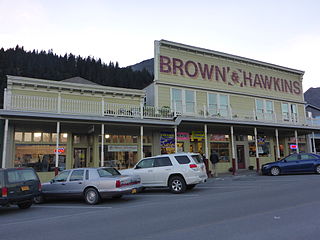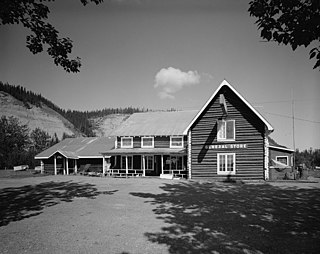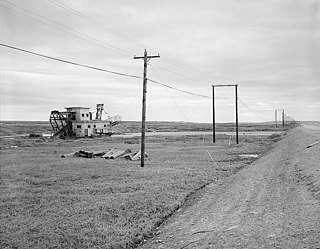
Klondike Gold Rush National Historical Park is a national historical park operated by the National Park Service that seeks to commemorate the Klondike Gold Rush of the late 1890s. Though the gold fields that were the ultimate goal of the stampeders lay in the Yukon Territory, the park comprises staging areas for the trek there and the routes leading in its direction. There are four units, including three in Municipality of Skagway Borough, Alaska and a fourth in the Pioneer Square National Historic District in Seattle, Washington.

Cape Nome Mining District Discovery Sites is a National Historic Landmark located in Nome, Alaska. It was named a National Historic Landmark in 1978. It is significant for its role in the history of gold mining in Alaska, in particular the Nome Gold Rush that began in 1899.

Biederman's Cabin, also called Biederman's Fish Camp, is a privately owned cabin on the Yukon River in Alaska. Located within the Yukon-Charley Rivers National Preserve, it is maintained as a historic site representing the subsistence lifestyle employed by Interior Alaska residents during the early years of the 20th century and is one of the few structures within the preserve.

Brown & Hawkins is a general store in Seward, Alaska. It was founded in 1904 to serve the town and those constructing of the Alaska Central Railroad, and has been the oldest continuously operating business in Seward. It was listed on the National Register of Historic Places in 1988. It was announced in 2013 that the owners were retiring without finding anyone to buy their business.

The F. Jacob Schmidt House is a historic building located in the West End of Davenport, Iowa, United States. F. Jacob Schmidt, who built this house, worked as a cooper. This Queen Anne style house was possibly ordered from a Victorian pattern book. It is a 1½-story structure with a projecting side pavilion. Its noteworthy feature is the sunburst pattern on the main gable. The Eastlake style porch has subsequently been replaced with one of a more simple design. The house has been listed on the National Register of Historic Places since 1983.

The Nome Gold Rush was a gold rush in Nome, Alaska, approximately 1899–1909. It is separated from other gold rushes by the ease with which gold could be obtained. Much of the gold was lying in the beach sand of the landing place and could be recovered without any need for a claim. Nome was a sea port without a harbor, and the biggest town in Alaska.

The Capt. George Raabe House in southeast Portland in the U.S. state of Oregon is a 1.5-story dwelling listed on the National Register of Historic Places. Built in 1902, it was added to the register in 1989.

The Cape Nome Roadhouse is the last remaining historical roadhouse on the Iditarod Trail. Built in 1900 to accommodate travelers to the Nome area during the Nome Gold Rush, it was soon expanded. It has a profile resembling that of a typical New England saltbox house, although its main entrance is on what would normally be considered the side of such a building. Its oldest portion is a log structure, which was expanded with lumber wood framing, and the whole building is now covered with clapboard siding. It is the only structure surviving from the route of a 650-mile (1,050 km) delivery of diphtheria serum in 1925 achieved by a relay of dogsled teams. The roadhouse declined with the advent of aviation to the area, and was used as an orphanage, a military communications facility during World War II, and saw used in the later 20th century as a retail establishment.
The Nome–Council Highway is a highway that runs for 71.970 miles (115.824 km) between the communities of Council and Nome in the Nome Census Area of the Unorganized Borough in the U.S. state of Alaska. The road travels east from Nome, following the shore of the Bering Sea until it reaches the ghost town of Solomon. From there, the route travels northeast through the interior of the Seward Peninsula before it terminates on the south bank of the Niukluk River, south of Council. One of three highways traveling from Nome to surrounding communities, the highway is disconnected from the rest of the Alaska Highway System. The route is unpaved for its entire length and becomes impassable for automobiles in the winter outside of a short portion immediately outside of Nome. The portion of the road between Nome and Solomon is part of the Iditarod Trail and the highway passes several historic sites associated with the trail and the area's gold mining history.

The Burkhart-Dibrell House, also known as Monrean House, is a historic house at 500 Main Street in Ketchikan, Alaska. This three story wood-frame house was built in 1904 by H. Z. Burkart, the founder of Ketchikan Spruce Mills, and is the only significant surviving Queen Anne style house in Ketchikan. It occupies a prominent position at the head of Main Street, and has long been a local landmark. In 1916, the house was purchased by Captain Walter Dibrell, Superintendent of Lighthouses for all of Alaska. The house's most prominent feature is its turret with conical roof and gold spire.

The Juneau-Douglas City Museum is located at the corner of 4th and Main, opposite the Alaska State Capitol in Juneau, Alaska. It occupies a building which was built in 1950–51 to house the Juneau Memorial Library. It is a two-story Classical Revival structure built out of concrete with red marble trim elements. A gable-roofed projecting section at the center of the long wall provides the main entrance, which is recessed in an opening the full height to the pediment. This projecting section is flanked by banks of five metal-framed awning windows. The northeast facade has a gable pediment similar to that of the entry projection, below which is a large rectangular window, behind which a stained glass decoration has been installed. The building served the city as its library until the 1980s, at which time it was repurposed to house the city museum.

The Gakona Roadhouse is a historic traveler service facility in Gakona, Alaska, at mile 205 of the Glenn Highway. It is a 1-1/2 log structure with a gabled roof covered in corrugated metal. A shed-roof addition extends to the main block's east side. The roadhouse was built c. 1904, during the construction by the United States Army of the Trans-Alaska Military Road between Valdez and Eagle. This roadhouse was strategically located at a place where that road diverged from the old Eagle Trail, used by miners to reach the gold rush fields of the Yukon River. The original 1904 structure is used for storage; the present roadhouse facilities are provided by later (1920s) structures.

The Fairbanks Exploration Company was the major economic force in the growth of Fairbanks, Alaska during its gold rush years in the early 20th century. In the 1920s the company built a number of housing units for its workers. A cluster of at least eight of these is known to have survived on the east side of Illinois Street, of which four have retained historical integrity. Located at 505, 507, 521, and 523 Illinois Street, they are all similarly built Bungalow-style wood-frame buildings, 1+1⁄2 stories in height, with a hip roof and projecting hipped wings. The complex includes a five-stall garage which served all four houses, as well as two greenhouses. At the time of their listing on the National Register of Historic Places in 1997, this group of houses was being rehabilitated for use as a bed and breakfast inn.

The Bureau of Indian Affairs Unalakleet School, also known as the Unalakleet Day School and BIA School and Quarters, is a historic school complex in Unalakleet, Alaska, a small community about 150 miles (240 km) southeast of Nome at the mouth of the Unalakleet River. The complex includes the main school building, a light plant, a warehouse and the former Teacher's Quarters, Clinic's Quarters and Duplex Quarters across 2nd Street. The school building is a Georgian Revival structure, 2+1⁄2 stories in height, built in 1933 with balloon framing, a gable roof with octagonal cupola, and a concrete foundation. Shed-roof dormers were added in 1937, and an addition in 1954. The building housed classrooms and other facilities on the first two floors, and two small apartments in the attic space. The school was built by the United States Bureau of Indian Affairs as part of a major program to assimilate Alaska's Native population, and was operated from these premises until 1978, when the state built a new school.

The Discovery Saloon is a historic building at 1st and D Streets in Nome, Alaska. Now a private residence, this two-story wood-frame building with false front was built in 1901 by Max Gordon, who operated a high-end public establishment on the premises. It is the oldest commercial building in Nome, and one of the few to survive from Nome's gold rush days. It was converted to one of Nome's finest private residences in the 1940s.
Pilgrim Hot Springs is a ghost town in the interior of the Seward Peninsula of northwestern Arctic Alaska. Also known as Kruzgamepa, it is located on the southeast bank of the Kruzgamepa River, about 8 miles (13 km) south of milepost 65 of the Kougarok Road. The location gained prominence in the early 20th century because of its thermal hot springs, which made agricultural homesteading possible, and which were adapted to provide a respite for the gold miners of Nome. Early buildings, built 1900–03, were of log construction, and included a log cabin, barn and chicken house. A roadhouse and saloon were built after 1903, but were destroyed by fire in 1908, after the mining boom had ended.

The Solomon Roadhouse, also known as the Curran's Roadhouse, is a historic travel accommodation in northwestern Arctic Alaska. It is a two-story frame building located a short way north of the small community of Solomon, which is at the mouth of the Solomon River about 30 miles (48 km) east of Nome on the Nome-Council Highway. The roadhouse was built in 1904, during the days of the Nome Gold Rush, which brought many miners to the Solomon River as well, resulting in the establishment of the communities of Solomon and Dickson, and the construction of a railroad. After the gold rush declined and the communities were devastated by storms and floods, the roadhouse and other buildings were relocated about a mile north of the coast in the 1930s. The roadhouse operated until the 1970s.

The Swanberg Dredge is one of several gold mining dredges that dot the landscape near Nome, Alaska. Also known as the Johnson-Pohl Dredge, this one is located at about mile marker 1 of the Nome-Council Highway just inside the city limits. The dredge stands in a pond about 200 feet (61 m) north of the highway in a small pond. It has a barge-like hull with a mostly single-story superstructure, and measures about 60 by 30 feet, with a draft of 6 feet (1.8 m). Its metal frame bow gantry extends about 5 feet (1.5 m), and has a digging ladder 40 feet (12 m) long. The dredge was built in San Francisco, California, shipped to Nome, and placed in operation in 1946 by Walter Johnson. The economics associated with the cost of its construction and shipment, as compared to the price of gold, worked against Johnson, who only operated it for a single season before it was seized by a local bank. It has sat in place since then, typifying the sometimes hard-luck small-time mining operations of the area.
The Teller Mission Orphanage was a historic orphanage and mission house located at Corner of Post Officer Road and Tuksuk Street in Brevig Mission, Alaska. This small community was established in 1891 as a station for the importation of reindeer from Siberia to supplement the diet of the local Alaska Native population. The reindeer station was taken over in 1900 by the Norwegian Evangelical Lutheran church, which also undertook to operate a school and orphanage at the site. The 1+1⁄2-story wood-frame building was built in 1917, replacing the original orphanage built in 1907 by Rev. Toleef Larson Brevig, for whom the community is named. It was about 28 by 54 feet, with a gable roof, weatherboard siding, and a metal roof. At the time of its listing on the National Register of Historic Places in 2001, it had been standing vacant for about 20 years. The building is no longer standing as of September 2015.

The Wireless Station is a historic US government telecommunications facility at East Manor and Boyd Streets in Anchorage, Alaska. The property includes three buildings that were used to maintain radio communications in the Anchorage area, with ships at sea, and as a communications link to Seattle, Washington as part of military WAMCATS telecommunications system. In addition, the station was used for communications during the construction of the Alaska Railroad, and, during the 1925 serum run to Nome, it was used to inform the residents of Nome that the diphtheria antitoxin was on its way.



















